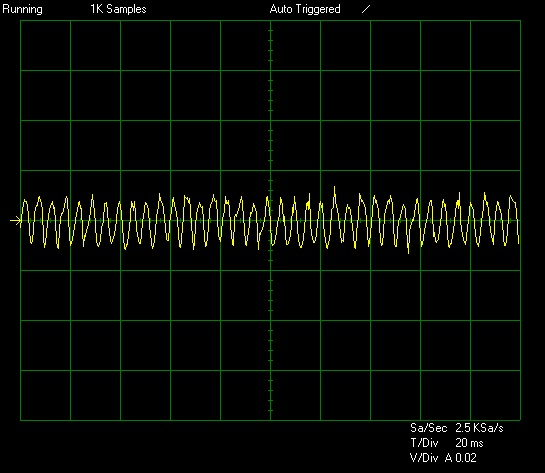AeroCool Integrator MX 700w Power Supply Review
Mike Sanders / 5 years ago
Introduction

AeroCool Integrator MX 700w
AeroCool is one of the best-known brands in terms of PC system components. Between their chassis designs, power supplies, cooling solutions and gaming ‘furniture’ they have continued over the years to produce products that always impress us here at eTeknix. A particular highlight has been their power supplies which have always proven to be solid and reliable.
With this in mind, we take a closer look at their latest offering, the Integrator MX. The specific model we have to test is the Integrator MX 700w power supply. A modular power supply which has just been recertified to a ‘Silver’ level of power efficiency. While it isn’t uncommon for power supplies to occasionally be ‘upgraded’ in terms of their efficiency rating, it is a little unusual for sure.
Lets, therefore, take a close look and see if the new rating and the power supply as a whole could be the right choice for your next PSU.

Features
The Aerocool Integrator MX comes with a number of key features that the more discerning power supply purchaser will find very impressive.
- Semi-Modular cable management by user’s system configuration.
- All direct DC cables with mesh sleeving and flat modular cables for reduce airflow interface.
- Compliant with the latest Intel ATX12V Ver.2.4 design guide.
- Fully compatible with the latest generation Intel Core Series processors starting from the 4th-generation CPU Intel ‘Haswell’ platform’s C6/C7 power saving mode.
- Up to 88%+ efficiency with official 80 PLUS 230V EU certificate.
- Single 12V rail for high compatibility and extremely high current output.
- Clear and Pure DC output quality with low ripple noise.
- 20+4P and CPU 4+4P cable length up to 550mm – easy reach to all components.
- Four PCIe 6+2 pin connectors for high-end graphics cards.
- 7 Sata connectors support multiple hard drives.
- 12cm silent cooling fan with smart thermal fan speed control circuit.
- Complete protection with OVP/UVP/OPP/SCP/SIP.
- Safety and EMC certified by CE, CB and TUV.
- ECO-friendly with Active PFC, RoHS and ERP 2014.

Cabling
With this being modular (well, technically semi-modular), it’s important to know exactly what cables this power supply is provided with. Although this is detailed on the rear of the packaging we will detail it for you below.
- 1 x 20+4 main power connector.
- 1 x ATX 12 V 4 + 4 PIN
- 7 x SATA
- 4 x 6 + 2 PCI-E
- 4 x Molex
- 1 X Floppy Disk Adaptor
In terms of connectors, this should be more than enough to connect any standard or even high-end gaming PC.
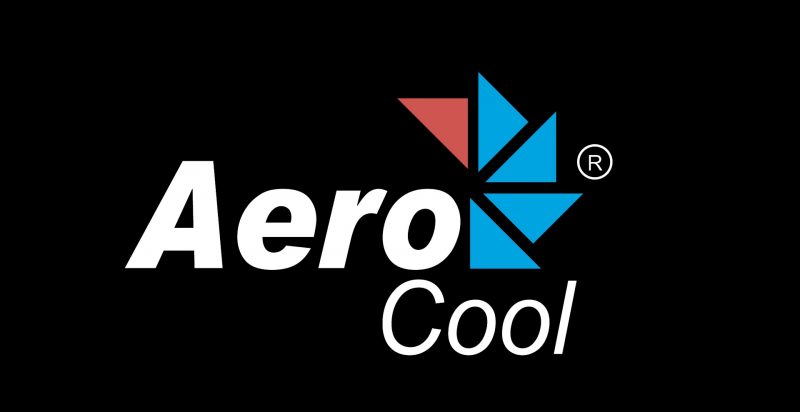
A Closer Look
Aerocool has presented the Integrator MX really well in the packaging. While the front of the packaging doesn’t give you a clear view of the power supply itself the information provided is nice, clear and bold. You may note in the image that the ‘Silver’ efficiency has been stuck onto the box. As above though, this has been recertified likely after the original packaging was made.
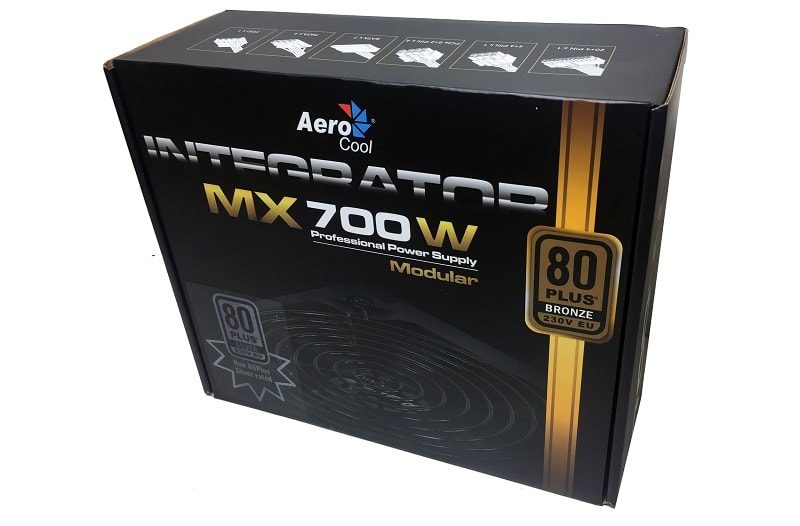
For what the front of the box lacks for, in detail, the rear easily makes up for it. Not only are you given a nice image of the power supply (as well as the semi-modular design) you are also given a very extensive list of it’s key features. In addition to this, you are also given the method in which the power is outputted to the specific voltages.
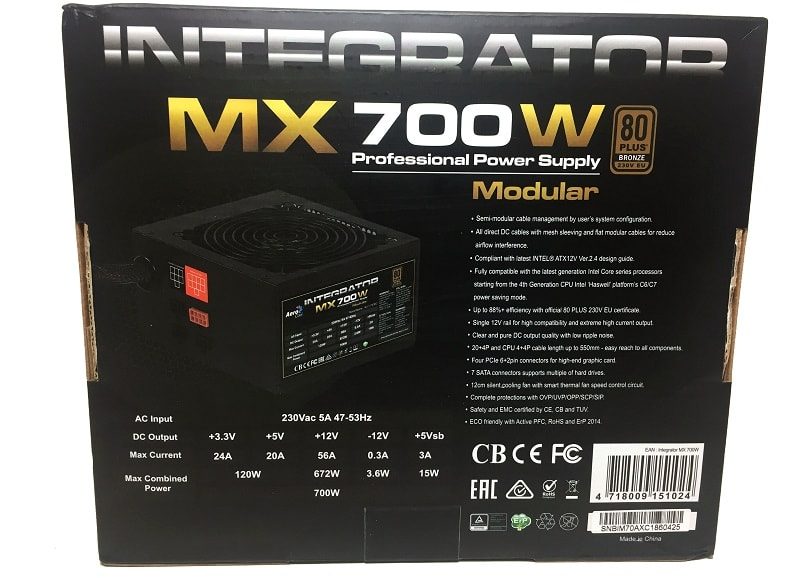
The Power Supply
The power supply has a nice strong aesthetic. While there is some Aerocool branding on it, the most notable aspect mostly contains product specific information rather than gaudy advertisements.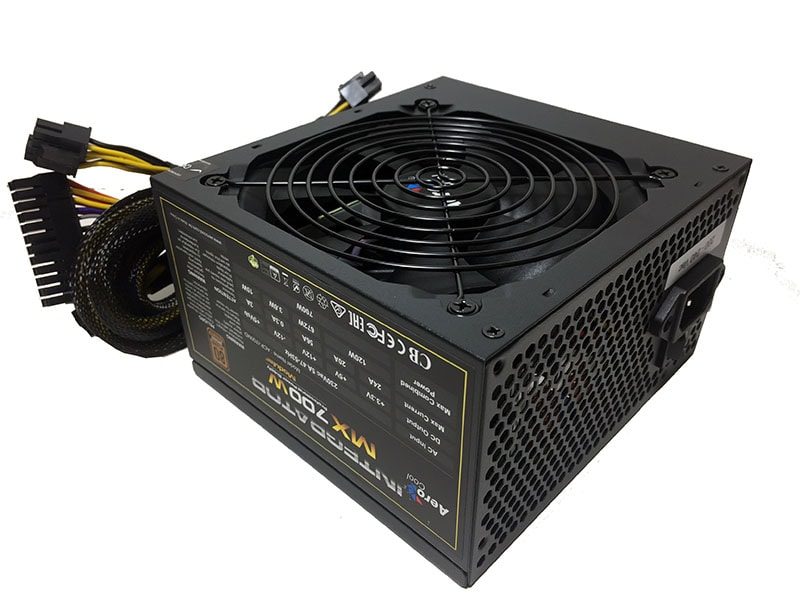
The Aerocool logo is found to the side and centre of the fan (which is protected by a nice guard). Without it being upside down, it’s also a bit easier to see just how well the information displayed directly on the block.

Despite the ‘modular’ to the front of the packaging, this is actually semi-modular. In semi-modular terms though, the design is a little unusual. Rather than giving you the basic cables attached, you actually have the vast majority as part of the cable bundle. The non-modular aspect is only a small smaller band for additional CPU/PCIe/peripheral ports as required. The non-modular aspect should only be considered in the frame of covering ‘unusual’ circumstances in a build.

While the main cables have a nice protective sleeving, the non-modular cables are a little more flexible. The lengths of all cables are pleasantly decent and as such, management/keeping things tidy shouldn’t be a chore.
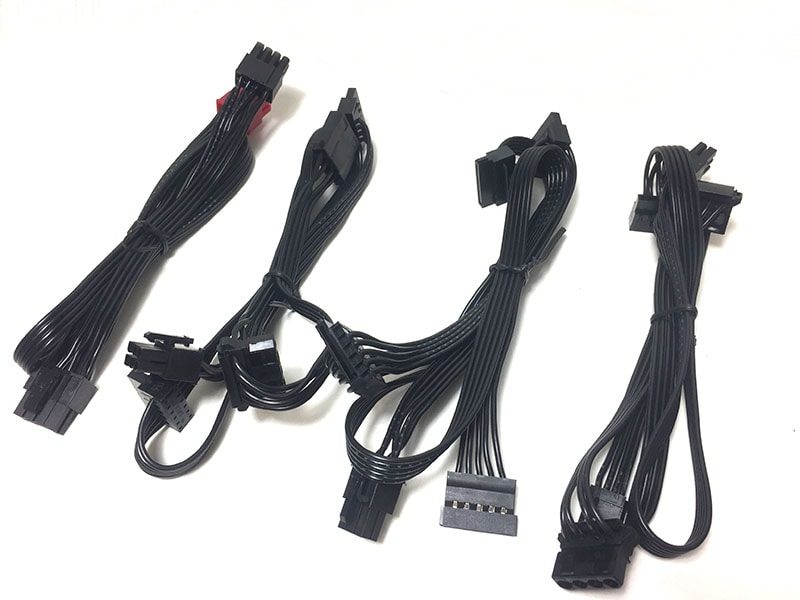
We should note that in terms of what you get with the power supply, it’s very minimal. You are given the additional non-modular cables, the bolts to attach it to your chassis and a manual. The manual is rather brief in it’s information and doesn’t much go into the warranty or specifics of the power supply.
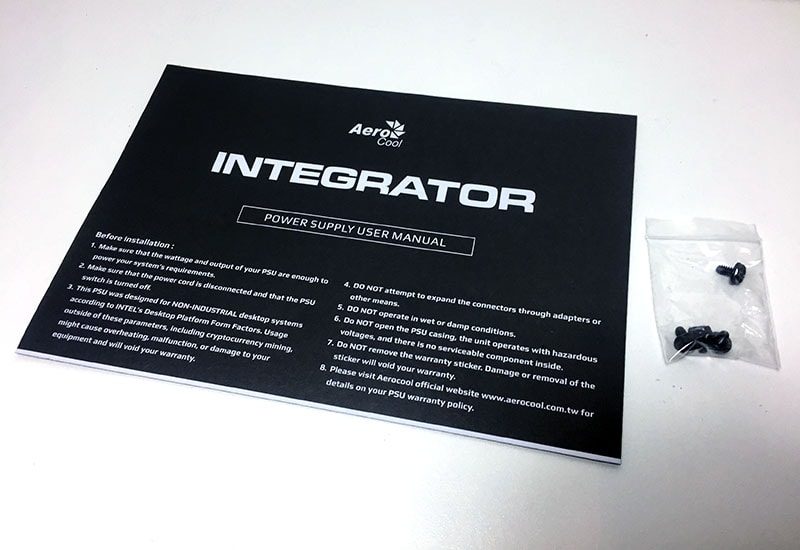
Interior
Once inside the power supply, the presentation, on the whole, is pretty decent. Given that this is more of a non-modular power supply, sometimes the innards can be a little messy. Particularly in terms of cables. At a glace though, things are fairly decent.
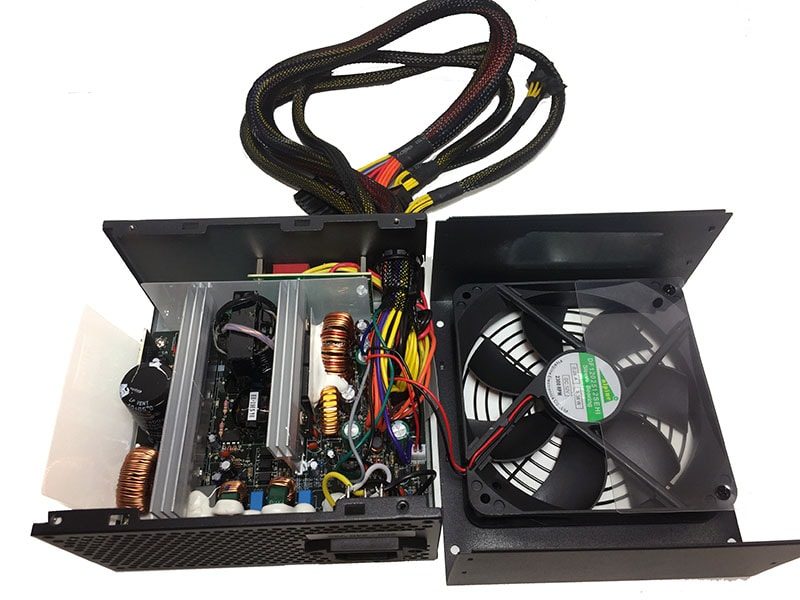
A closer look at the power supply internals does show a lot of ugly glue placement. Something we always tend to mark a product down over. If something has to be stuck into a system, it’s always preferable to see a little more care in the application. On the positive side though, the head sinks are nicely located to the centre and as a whole, the key components are well spaced.
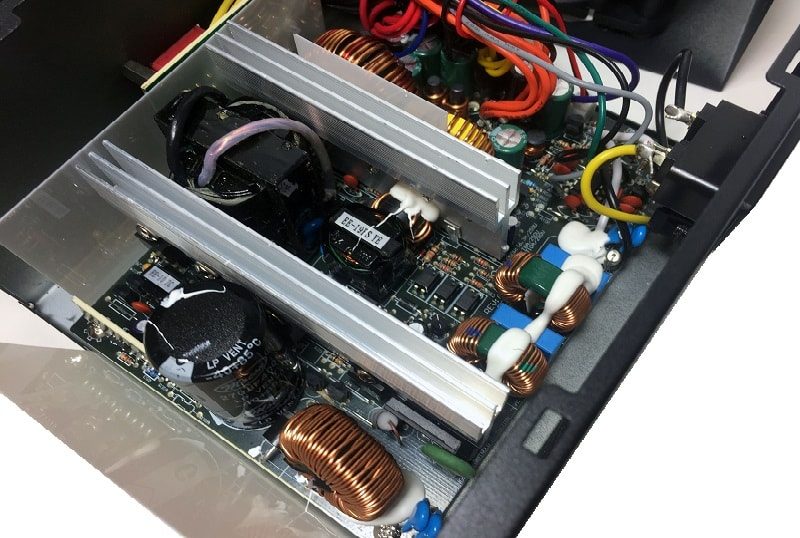
The main capacitor is a Mscon brand which is rated up to +85c. In terms of comparative capacitors, there are better models available. Specifically, those rated to 105C. Try as much as I can, I can not find the specific country of origin of design and as such, I’ll have to leave that conclusion a little open-ended.
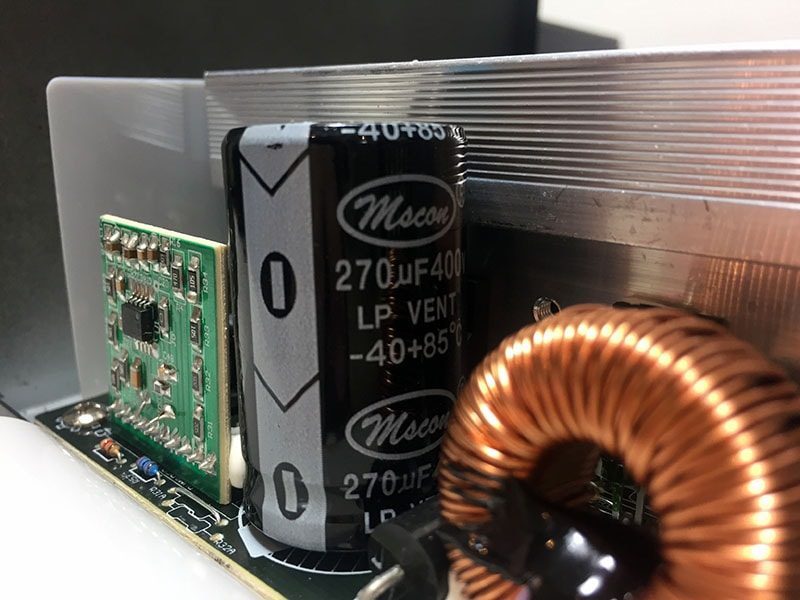
Important – Please Read
To understand the results on the new few pages, please take the time to read our detailed testing methodology page. The next page of this review will help you understand what the results of our testing mean, and educate you on the various qualities we look for in a good PSU.
Test Procedure
At eTeknix we take the power supply testing procedure very seriously and have invested a lot of resources into acquiring the appropriate testing equipment. For all power supply reviews, we test the power supplies with dedicated power supply testing equipment. This means we are able to get the most accurate results from our testing as opposed to using software benchmarks (such as OCCT) or multi-meter readouts which are broadly inaccurate.
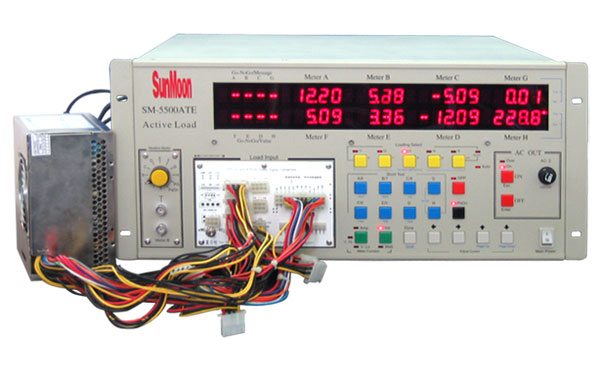
Testing Hardware
- Sunmoon SM-5500ATE Active Load Tester (1200W rated)
- Stingray DS1M12 USB Oscilloscope
- Voltcraft DT-10L laser tachometer
What the eTeknix Test Procedure Involves
- Testing each power supply at 20/40/60/80/100% load (with load balanced across all rails) and measuring PFC (power factor correction), efficiency (actual power divided by power “pulled at the wall”) and voltage regulation (deviance from expected voltages of 3.3/5/12 on the main rails).
- Measuring ripple with an oscilloscope at 20/40/60/80/100% load.
- Measuring fan speed after a stabilisation period of five minutes at each load scenario using the Voltcraft DT-10L laser tachometer and a reflective strip on the fan.
- Testing each power supply’s OPP (Over Power Protection) mechanism and seeing how many watts each power supply can deliver before shutting down
Other Things to Consider
- We recognise that a single 12-volt cable can provide only 6 Amps before overheating (which corrupts voltage regulation and efficiency) and so we used an adequate number of cables for each power supply to ensure there is not efficiency loss from poor cables selection
- Our Sunmoon SM-5500ATE power supply tester is not capable of testing more than 300W on each of the 12-volt rails so where a power supply provides more than 300W on a 12-volt rail that power is distributed over multiple 12-volt rails on the load tester. For example a power supply with one 12 volt rail supplying 750 watts would be spread equally over three 12 volt rails on the load tester, a power supply with two 450W 12v rails would be spread over four 12v rails on the load tester, two 225W 12v rails for each of the 12v rails on the unit.
- We use the same time scale and horizontal millivolt scale on our oscilloscope for all ripple tests, that is a 20ms T/DIV (horizontal) and a 0.02 V/DIV (vertical) meaning the scale is from -80mV to +80mV, ATX spec dictates that the 12v rail must fall within 150mv of ripple and the 3.3/5 within 50mv so that scale allows us to include both 150 and 50mV peaks. (Some older PSU reviews use different scales which were later ditched as the visual representation they give is inadequate, in these reviews written measurements are provided only).
- Deviance is the terminology used to represent the way voltages diverge from the expected values
Voltage Regulation
To test voltage regulation we load the power supply to five different load scenarios that give an equal spread of load across every single rail. So that means 20% on all rails, 40% on all rails and so on. We then calculate the average deviance of each rail from its expected voltage. Ideally, anything of +/- 2% regulation is seen as a very good result.
Power Efficiency
Power efficiency is measured by calculating actual supplied wattage divided by the wattage drawn at the wall/plug, multiplied by 100 to give a percentage. We then compare that to the particular 80 Plus certification the company claims to see if it meets that. You can see the 80 Plus certifications below, we always test power supplies at 230v.
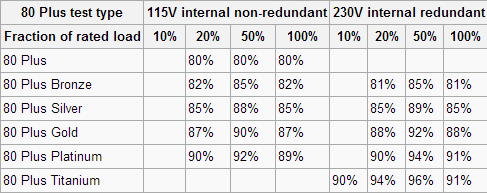
Power Factor Correction
Power Factor Correction is the ratio of the real power flowing to the load, to the apparent power in the circuit. The aim of PFC is to make the load circuitry that is power factor corrected appear purely resistive (apparent power equal to real power). In this case, the voltage and current are in phase and the reactive power consumption is zero. The closer the number to one the better as this allows the most efficient delivery of electrical power (Source – Wikipedia).
Ripple
Noise and Ripple can easily be measured by an oscilloscope. These show how much voltage fluctuation there is on a particular rail. We tested the rail stability of the 3.3-volt, 5-volt and 12-volt rails using an identical time and millivolt scale for all graphs. millivolt ripple is measured by the peak to peak size of the voltage curve.
The latest ATX 12 volt version 2.3 specifications state that ripple from peak to peak must be no higher than 50 millivolts for the 3.3-volt and 5-volt rails, while the 12-volt rail is allowed up to 120 millivolts peak to peak to stay within specifications. Millivolt figures are stated to the closest increment of 5 given their variability.
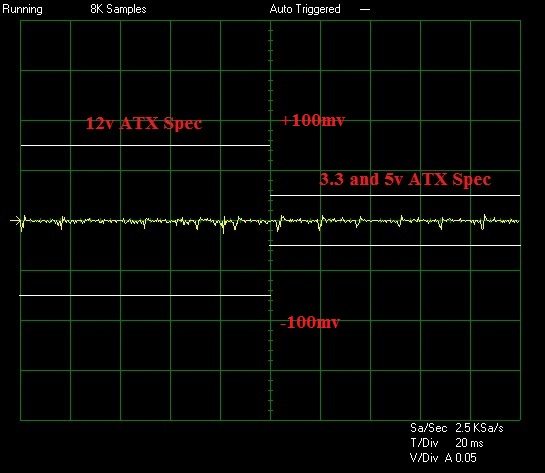
OPP
Power supplies often quote as having various protection mechanisms such and the most important of these is Over Power Protection. In our testing we crank up the power draw until the power supply either shuts down (meaning the OPP mechanism is present and working) or blows up (meaning it is either not present or not working). We then note the maximum power consumption before the power supply shut down, or before it blew up.
Fan Speed
When testing in a power supply laboratory it is difficult to take fan noise readings as the noise from the Sunmoon test equipment and air conditioning corrupts everything. The next best thing in our circumstances was reading off the fan speed with a tachometer to get an idea for the noise. The ambient temperature during testing held constant at 22 degrees, with 1 degree of variation. Each power supply had a consistent time period of 5 minutes to stabilise between each load scenario.
In my experience, the following general relationships apply between noise levels and fan speeds, though it can vary greatly between the type of fan used.
- Below 800 RPM – Inaudible/Silent
- 800 to 1000 RPM – Barely audible
- 1000 – 1200 RPM – Audible but still quiet
- 1200 – 1400 RPM – Moderately noisy
- 1400 – 1800 RPM – Noisy
- 1800 RPM or above – Intolerable
Efficiency, PFC and Voltage Regulation
Voltage Regulation
The AeroCool Integrator MX 700w is not an overly expensive power supply. As such, you might be interested as to exactly how good this is in terms of our testing. Well, starting off with the voltage regulation, the results are, on the whole, not bad. It is, perhaps a little concerning to see the main +12V volt operating consistently below 12v. On the positive side though, all of the results are remarkably consistent with each other. Regardless of the load. As such, while they are not perhaps fantastic, they are by no means bad either.

Power Efficiency
Given that AeroCool recently had this power supply recertified to silver efficiency rating, it clearly has to perform much better than the standard 80 PLUS Bronze. With that in mind, the Aerocool Integrator MX certainly warrants the improved certification. While it tiptoes into the realms of Gold at points, this is very definitely silver in its performance.
Power Factor Correction
While the PFC ratings are a little low at 20% load, once the power is cranked up, the results get a lot more pleasing to the eye. Actually, beyond 20% the results are nearly exact with only a small improvement seen as it climbs towards 100%. This isn’t, incidentally, a criticism as even the 20% result is much better than most power supplies manage at their best.

Ripple
Given that one of the key features of the Aerocool Integrator MX is a low ripple noise, we were expecting some very low scores here in testing. In truth though, the results were, on the whole, much higher than we anticipated. While all of the results are well within the EU standards, the 39.6 at 100% in the 12V scoring certainly made us raise an eyebrow.
This isn’t knocking the results. As above, they are all perfectly acceptable. To make such specific note of ‘low-ripple noise’ on the box though and to see something different in our testing is certainly unusual (but not uncommon). We guess it must depend on what your definition is.
| Load (%) | 3.3V Ripple | 5V Ripple | 12V Ripple |
| 20 | 8.4 | 19.6 | 21.4 |
| 40 | 17.8 | 14 | 23 |
| 60 | 15.6 | 17.2 | 25.2 |
| 80 | 20.6 | 16.2 | 23.8 |
| 100 | 24 | 20 | 39.6 |


Over Power Protection and Max Wattage
With this being a 700w power supply, it should have more than enough to support most gaming PCs. In terms of what extra it can offer though, when put to the over power protection test, we can confirm that the protection works and the power supply was able to draw an addition 119w above the rated amount. This doesn’t leave you with much wiggle room in terms of additional performance, but it is a relatively comfortable margin.
![]()
Fan Speed
The cooling fan for the Integrator MX seems to operate on 2 separate levels of speed. Up to 60%, the fan ran at a near consist 925rpm. When pushed to the higher levels of performance it runs at about 1250rpm. While the cooling fan speed doesn’t show much modulation or reaction to specific instances, the fan should easily cope with higher-performance when you ask it.

Final Thoughts
Pricing
The Aerocool Integrator MX 700w retails for a price in the region of £39.99 (click here for confirmation as to where to buy). In terms of price comparison, this places it roughly in the tier above entry-level in terms of price. When you consider though that this is giving you a silver-rated level of efficiency, it actually represents some remarkable good value. Often, a similar 700w power supply (with silver rating) will cost at least £10-£20 more.
Overview
In terms of presentation, the Aerocool Integrator MX has a nice exterior presentation. The power supply looks exceptionally solid and while their is branding on the power supply, it’s actually most useful information rather than outright advertising.
Internally, it could be better. As above, the amount of glue on components makes it look messy and it’s always a moderate alarm bell for the overall quality in which it has been put together. From our testing though, this PSU was more than good in terms of its results.
Efficiency and Beyond
It’s quite unusual (but not unheard of) for a manufacturer to apply for higher certification on a power supply. In this regard, Aerocool seems to be entirely warranted in their decision as to the Integrator MX falls comfortably within the silver efficiency ratings. At times, it almost errs towards gold, but not quite.
When you consider this, in terms of the price, this is certainly ticking a lot of the right boxes.
Should I Buy One?
Many people prefer to steer away from non-modular power supplies or at least prefer to go down the semi-modular road where only the motherboard and CPU cables are fixed attachments. With this in mind, despite the packaging (and this technically being semi-modular), this is essentially non-modular. To call this ‘modular’ on the packaging is, in our opinion, inaccurate and misleading. Fortunately, the rear of the box work corrects this to a degree, but it is a factor worth noting.
For less than £50 though, you shouldn’t quibble too much on the cabling and attention should more be paid towards the efficiency and overall quality. While there are some question marks over the latter, the efficiency ratings proved to be excellent.
For a low-cost power supply though, the Aerocool Integrator MX is perhaps one of the best value silver rated power supplies out there.

Aerocool Integrator MX 700W Power Supply Review

